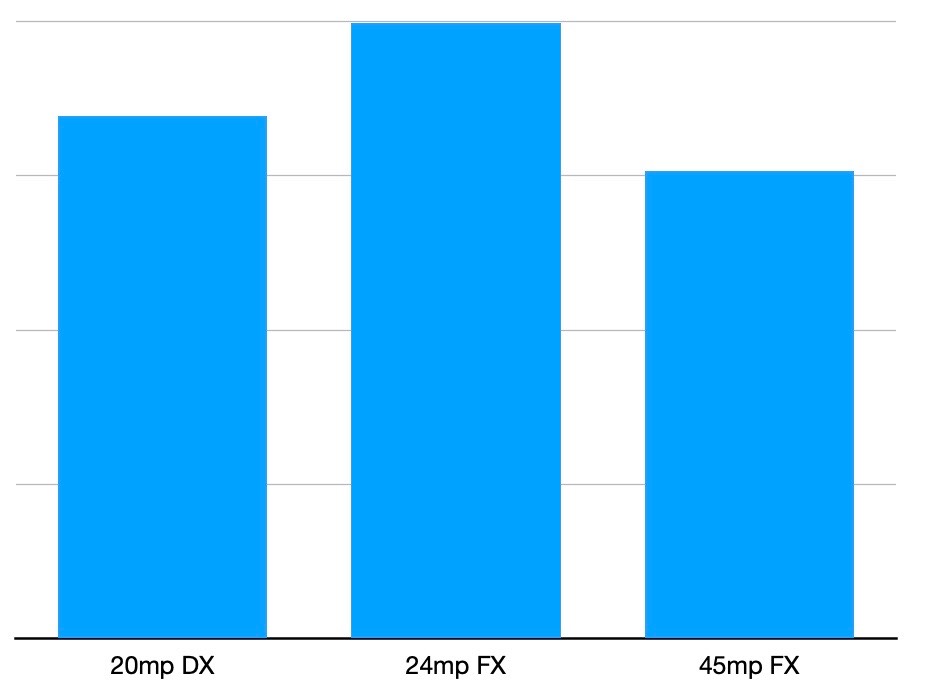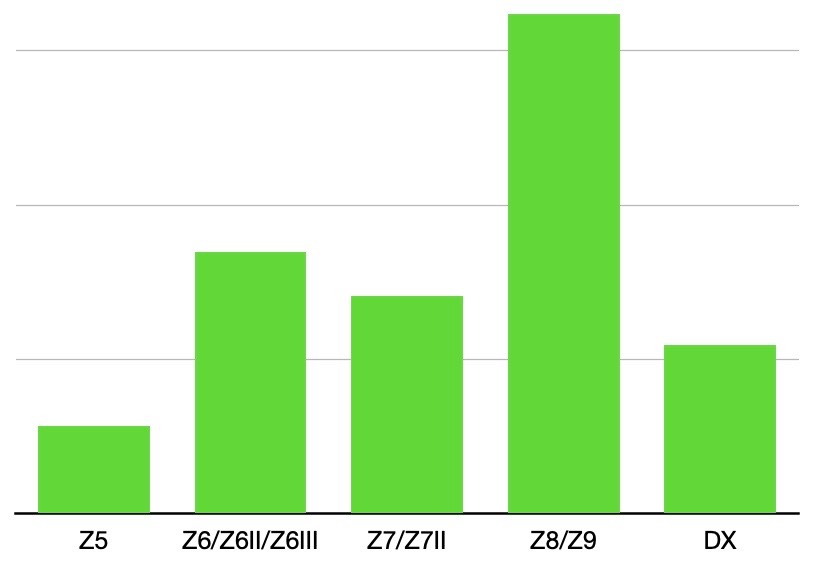Long gone are the days when Nikon used to sell millions of cameras a year. Their current fiscal year forecast is that they'll sell 850k interchangeable lens cameras over 12 months (April 2024 thru March 2025). Aligning available CIPA, market share, and Nikon numbers, I'd project that for the year through to March 2025 Nikon will likely have sold somewhere in the neighborhood of 200k DSLRs and 650K mirrorless cameras. The scale keeps shifting every month more towards mirrorless, so that 650K might end up being an understatement, or perhaps a late season DSLR inventory push could move that number briefly upward instead.
It's almost impossible to get verifiable unit sales of the Z cameras on a global basis. The serial number database that most turn to is missing a lot of data, particularly from Asia and China. Since the serial numbers are crowd-sourced from an English-speaking country, it's questionable if it's up to date or fully reflective of the true global situation. However, the US serial number tracking in that database is pretty close to my own, so let's examine that subset for a moment.
One thing I've been trying to figure out is where the buying energy is in the Z System. Here's what my own US serial number collection suggests the number of units is for each category (I’m leaving off specific numbers because it’s the relative volumes that we need to talk about, not argue about whether the individual numbers accurate to Sigma 6 standards):

One contention has been that Nikon has only been doing well with the higher end of their lineup. That's usually coupled with statements like "DX isn't important any more" or "Nikon needs to abandon the low end." I've never believed that to be the case, and the more data I look at, the more I'm convinced that DX really has to continue for Nikon to have long-term volume success. Without volume success, the remaining cameras would have to get pricier, making Nikon into a smaller, Leica-like camera company.
Meanwhile, for those waiting for a Z7III, what does the above volume map tell you? At 45mp, the Z8/Z9 is doing significantly better in three years than the six-year history of the Z7 series. Let's chart the same data a little differently, though:

This volume is a bit more balanced than I would have guessed. Price elasticity of demand (slightly) explains the two right-most columns, but DX is conspicuously underperforming in that respect. Some keep trying to say the DX market is going away and will probably use the above chart to defend their position, but I still contend that it's more a problem with the offerings and lineup. The Zfc, for example, has outsold the Zf about 3:1. The Z50, as a five year old camera that didn't age well was another issue, so we'll see soon if the Z50II with all its Z9-generation benefits changes that.
Finally, if we target average retail selling prices, we can take that volume and calculate how dollars might have been collected in the US market. I used US$1200 for the Z5 average selling price, US$1800 for the Z6 series, US$2800 for the Z7 series, US$5000 for the Z8/Z9, and US$850 for the DX bodies. Unfortunately, repeated instant rebates and price changes over time makes it so we have pick a mean value, and mine could be off ±10%. Still, there’s a pretty dramatic result:

These are definitely back-of-the-envelope figures, but still, it might tell you why we got a Z50II sooner than a Z5II and a Z6III before a Z7III.
Nothing in this (admittedly casual) analysis changes my ideas about how Nikon should explore new models. Put simply:
- Z9II needs to fix the small rough edges, get a better EVF, and up the performance some via an auxiliary AI chip/EXPEED8.
- Z8II should go to a higher pixel count sensor to separate a bit from the Z7III and Z9II.
- Z7III should pick up EXPEED7 and get its Z9-generation refresh as the Z8II moves away from 45mp.
- Z5II should eventually pick up EXPEED7 and get its Z9-generation refresh, but it's not immediately necessary.
- Z30II should pick up the Z50II changes that are relevant in order to stay current.
All the other models (Zfc, Zf, Z6III) should probably wait for a new image sensor, one that's more than 24mp or has some other advantage that the current ones don't. Again, this is just my opinion, not necessarily what Nikon will do.
Nikon has sold enough Z8 and Z9 models to distort the income numbers to the very highest end of their lineup. The excellence of those cameras is part of the "Nikon's back" thoughts many now have. I'm sure the Nikon management team is all grinning at themselves for having pulled off that trick. The trickle down of that technology will have strong effects in DX, a bit less so in the older Z5/Z6/Z7 model lines.
What everyone is now waiting to see is one of two things: (a) when the Z9 tech gets to their model (Z30, Z5, Z7II); or (b) what the next tech highlight will be (most likely to show up in a Z9II or Z8II, but more on that in another article coming soon).
